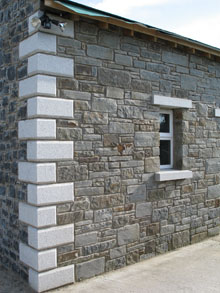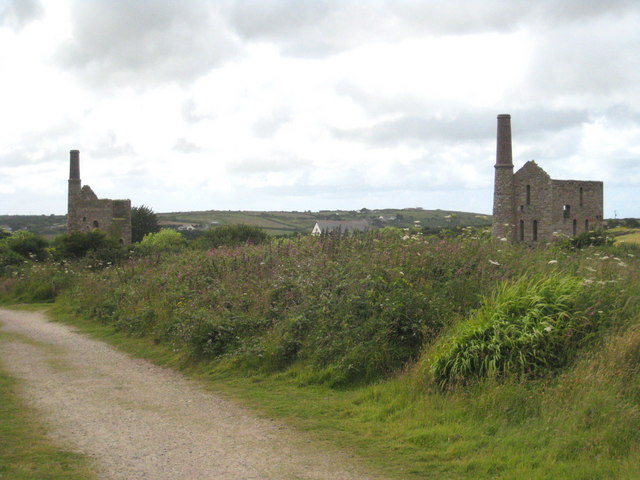South Wheal Frances was a copper and tin mine to the south of Camborne in Cornwall. It was named after the mineral lord, Lady Frances Basset, who in 1834 granted a lease for the mining sett,[a]A sett is an area of land leased for mining.[1] although parts of it had already been worked in the previous century.
The mine was most profitable in the 1850s, when the copper trade was booming in Cornwall. As the copper ore was exhausted during the 1860s, it was replaced by tin from the Great Flat LodeLarge ore-bearing body of rock under the southern slopes of Carn Brea, south of Camborne in Cornwall, England. Large ore-bearing body of rock under the southern slopes of Carn Brea, south of Camborne in Cornwall, England. , which was encountered from Pascoe’s shaft in 1875. A third shaft, Daubuz shaft, was started in 1879 after the Great Flat Lode had been reached. After a short period of prosperity the mine was once again in financial difficulty, and in 1892 amalgamated with its neighbour, West Wheal Basset, as South Frances United. The mines were by then in poor condition, but the company managed to limp on until its liquidation in 1918.
The site contains several listed structures, and is part of the Cornwall and West Devon Mining Landscape, a World Heritage site first listed in 2006.
Location
South Wheal Frances was a large mining sett between Treskillard and Carnkie south of Camborne in Cornwall.[2] Its workings were concentrated at the west end of a group of productive tin and copper lodes[b]Ore veins[3] that were also mined by the setts of Wheal Basset and West Wheal Basset.[2]
History
Mining for copper at South Wheal Frances was documented in the 1820s.[4][5] A horse whim and a pumping engine were installed in 1825, and tin ore was encountered five fathoms (9 m)[c]A fathom is an English measurement of 6 feet used for both vertical and horizontal distances in Cornish mining.[6] below the adit that drained the mine. The mine was offered for sale in 1825, but had not been sold three years later. After Lady Frances Bassett,[d]Lady Francis Bassett was the only child of Francis Basset, 1st Lord de Dunstanville and Basset. the mineral lord after whom the mine was dedicated, offered a new lease in 1834, production resumed.[2][5] By 1842 more than £2,200 had been expended, and a pumping engine was operating in 1845. In 1844 the mine produced 777 tons of copper ore. Two years later, after high-grade ore had been encountered, more than 2,200 tons of copper ore were sold at nearly twice the local rate.[7]
The mine complex is centred on Marriott’s shaft, where a 92 hp steam engine with a 75-inch by 11-foot cylinder and its associated works costing £1,000 had been erected by 1848. The mine had reached the 11 fathom level in 1852, and in 1856 more than 6,000 tons of copper ore was produced. In 1855 the 160-fathom depth had been passed. Tin ore was also produced and processed by water-powered stampsLarge machines for crushing tin and copper ore..[8]
A skip winder was erected between Marriott’s and Pascoe’s shafts in 1857. and wire ropes rather than chains were bought for it the same year. It enabled skips holding 1.25 tons of ore to be raised from the 188-fathom level in less than three minutes.[9] In 1858 a discovery of ore was made, and other significant discoveries were made the following winter, but by then copper production was in decline. Black tin production started in 1852, but not significantly until the late 1870s.[10] The 1860s were dominated by a dispute over the sett boundary with West Basset.[11]
In 1864 Pascoe’s shaft was being sunk to the 134-fathom level, and was below the 144 level by 1866; the mine was drained from Marriott’s shaft. But despite the investment, the mine was barely profitable.[12]
In the mid-1870s the extent and continuity of the Great Flat LodeLarge ore-bearing body of rock under the southern slopes of Carn Brea, south of Camborne in Cornwall, England. Large ore-bearing body of rock under the southern slopes of Carn Brea, south of Camborne in Cornwall, England. had become apparent, and by April 1876 Pascoe’s shaft was within six fathoms of cutting through it. The shaft was completed in September, but had cost a considerable sum. Rich ore close to Pascoe’s shaft was extracted, but the mine suffered from poor ventilation. The pumping engines at the tin stamps and Marriott’s shaft were worn out. New winding engines were bought.
Another shaft to the west of the sett, named after a major shareholder, Daubuz’s shaft, was sunk after pressure from the mineral lords after the Great Flat Lode had been reached. A 30-inch steam engine was erected in 1879 to hoist and pump the new shaft, and its engine house was built the following summer.[4][13]
In early 1889 heavy rain caused the mine to flood, and work was only possible in the shallower levels until the deeper levels could be drained.[14] Black tin production had declined after 1883 and the mine was in “ruinous” condition. The engines broke causing flooding and the financial situation was dire.[15] Salvation came when the mine was amalgamated with West Wheal Basset mines in 1992 as South Frances United.[4] Money was spent on repairs and a narrow-gauge railway was built to take ore from South Wheal Frances to the Basset stamps.[15] The new company struggled on, Daubuz’s shaft was still not completed. Fire damaged the head frame at Pascoe’s shaft in 1894 and the outlook was bleak, but the company limped on with “obsolete and worn out equipment”. After Marriot’s engine was burnt out, it was replaced by a gigantic compound engine built by Hathorne Davey of Leeds. and the winding engine was replaced by one from Holman’s of Camborne at a cost of £3,600.[16]
Between 1844 and 1891 South Wheal Frances produced 67,823 tons of copper ore and 6,907 tons of black tin. Between 1893 and 1895 South Frances United produced 43 tons of copper ore and 2,809 tons of black tin.[17]
The company went into liquidation on 31 December 1918.[18]
Legacy
The site of the South Wheal Frances mine complex is part of the Cornwall and West Devon Mining Landscape, a World Heritage site first listed in 2006.[19] It is marked by extensive remains around Marriott’s and Pascoe’s shafts. The surviving features include the derelict, roofless winding engine house to Marriott’s shaft that was built in the 1890s. It is constructed of granite rubble with quoins 
Any external angle or corner of a structure.and brick arches to the window openings. As are most remains on the site, it is a Grade II listed building. It contained a horizontal cross-compound engine made by Holman’s with 23 and 43-inch cylinders either side of its conical winding drum.[20] The derelict boiler house at Marriott’s shaft is also built of granite rubble with quoins at the corners and brick arch openings. Now roofless, it once contained six Lancashire boilers to power a pumping engine, winder, compressor, crusher, and capstan.[21]
The derelict pump engine house to Pascoe’s shaft is built of granite rubble and its bob wall is built of large dressed granite blocks. Its chimney is attached at south-west corner. It replaced the old pumping system by flat-rod connections from Marriott’s shaft and contained an 80-inch cylinder powered by four Cornish boilers.[22]
The derelict Daubuz’s pumping and winding engine house has three stages with round-headed openings in uncoursed granite rubble with quoins. Its bob wall is built of large dressed granite blocks with brick window arches. The remains of the boiler house are attached to south side, and the chimney at its north-east corner.[23]




